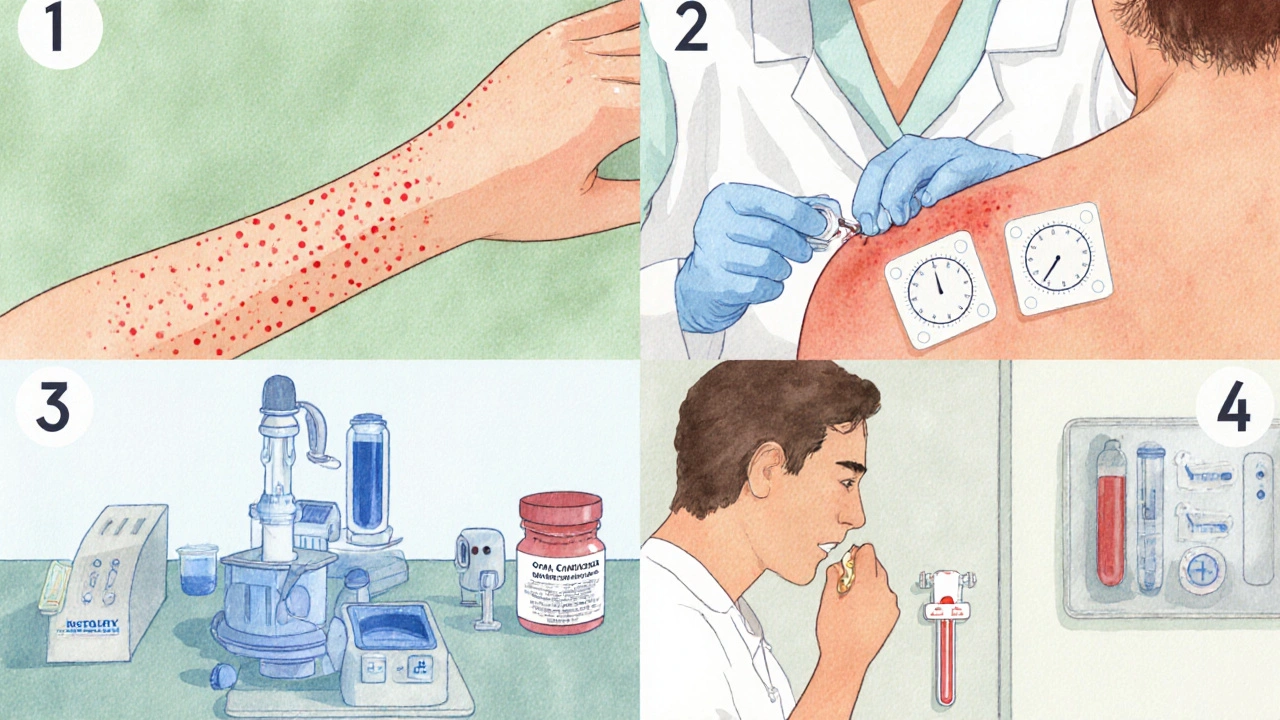Allergy Test Comparison Guide
Select a test type below to learn about its features, best uses, and cost:
Skin Prick Test
Quick office procedure for detecting inhalant and food allergies
Specific IgE Blood Test
Measures antibodies in blood for patients unable to undergo skin testing
Patch Test
Detects delayed-type hypersensitivity reactions like contact dermatitis
Oral Food Challenge
The gold standard for confirming food allergies under medical supervision
Test Comparison Table
| Test | Sample Needed | Sensitivity | Best Use Cases | Cost (US$) |
|---|---|---|---|---|
| Skin Prick Test | Allergen extracts on skin | 85-95% | Inhalant & many food allergens (children) | 30-80 |
| Specific IgE Blood Test | Venous blood | 70-90% | Patients on antihistamines, eczema, or dermatographism | 100-250 |
| Patch Test | Allergen patches on back | 80-90% | Contact dermatitis, suspected metal or cosmetic allergies | 150-300 |
| Oral Food Challenge | Controlled food ingestion | 100% | Confirming or ruling out food allergy when other tests are inconclusive | 200-500 |
When doctors suspect an allergic condition, allergy testing is a set of medical procedures that uncover hidden sensitivities and guide proper treatment.
TL;DR - Quick Takeaways
- Allergy testing pinpoints the exact trigger, preventing trial‑and‑error avoidance.
- Three main clinical tests exist: skin prick, specific IgE blood, and patch testing.
- Choosing the right test depends on age, symptom type, and medical history.
- Proper preparation (medication pause, skin prep) boosts accuracy.
- Results drive targeted therapies such as avoidance, medications, and immunotherapy.
Why Testing Beats Guesswork
Imagine suffering from chronic sneezing, itchy eyes, or stubborn eczema and spending months blaming dust, pet dander, or even stress. Without testing, you’re navigating blind, risking unnecessary diet restrictions and medication side‑effects. Allergic disorders are immune‑mediated conditions like allergic rhinitis, asthma, and atopic dermatitis that arise when the body overreacts to harmless substances. Pinpointing the exact allergen changes everything: you can eliminate the true culprit, avoid costly “until it works” diets, and focus on proven treatments.
Core Types of Allergy Tests
Three clinical methods dominate the diagnostic landscape. Each has strengths, limitations, and ideal scenarios.
Skin Prick Test (SPT)
Skin prick test is a quick in‑office procedure where tiny drops of allergen extracts are introduced to the skin's surface. Within 15‑20 minutes, a raised wheal indicates sensitization. SPT excels at detecting inhalant allergies (pollen, mold, pet dander) and many food allergens in children.
Specific IgE Blood Test
Specific IgE test measures the amount of allergen‑specific immunoglobulin E antibodies circulating in the bloodstream. Blood is drawn and sent to a lab, often using platforms like ImmunoCAP. This method is ideal when skin conditions, antihistamine use, or severe eczema prevent reliable skin testing.
Patch Test
Patch test detects delayed‑type hypersensitivity reactions by adhering allergen‑impregnated patches to the back for 48‑72 hours. It’s the gold standard for contact dermatitis caused by metals, fragrances, or preservatives.
Oral Food Challenge (OFC) - The Ultimate Confirmation
When blood or skin results are ambiguous, a supervised oral food challenge is the controlled ingestion of a suspected food allergen under medical observation provides definitive proof. Because OFC carries a risk of anaphylaxis, it’s performed in a clinic with emergency equipment.
Comparing the Main Tests
| Test | Sample Needed | Sensitivity (Typical) | Best Use Cases | Approx. Cost (US$) |
|---|---|---|---|---|
| Skin Prick Test | Allergen extracts on skin | 85‑95% | Inhalant & many food allergens (children) | 30‑80 |
| Specific IgE Blood Test | Venous blood | 70‑90% | Patients on antihistamines, eczema, or dermatographism | 100‑250 |
| Patch Test | Allergen patches on back | 80‑90% | Contact dermatitis, suspected metal or cosmetic allergies | 150‑300 |
| Oral Food Challenge | Controlled food ingestion | 100% | Confirming or ruling out food allergy when other tests are inconclusive | 200‑500 |
Preparing for Your Appointment
Even the best test can give false results if you’re not ready. Follow these practical steps:
- Pause antihistamines. Most oral antihistamines (e.g., cetirizine, loratadine) should be stopped 5‑7 days before skin testing. Discuss alternatives with your doctor.
- Avoid topical steroids. If you use steroid creams for eczema, stop them on the test area for at least 48 hours.
- Bring a medication list. Include supplements, over‑the‑counter drugs, and recent vaccinations.
- Wear comfortable clothing. Shorts or a short‑sleeve shirt makes access to the forearm or back easier for skin and patch testing.
- Fast if required. Some labs request fasting before a blood draw, especially if they’ll run a full allergy panel.

Understanding the Results
Clinicians translate numbers and wheal sizes into actionable advice. Here’s what to expect:
- Positive skin prick. A wheal larger than 3mm compared to the negative control generally indicates sensitization. However, sensitization ≠ clinical allergy; the doctor correlates with your history.
- IgE levels. Results are reported as class 0‑6. Class 2 (0.35-0.70kU/L) often suggests mild sensitivity; higher classes point to stronger likelihood of symptoms.
- Patch test reactions. Graded from ‘negative’ to ‘strong positive’ based on redness, swelling, and vesicle formation.
When results are ambiguous, a physician may schedule an oral food challenge to confirm true allergy. This step prevents unnecessary lifelong food avoidance.
From Diagnosis to Management
Identifying the trigger is only the first chapter. The real benefit lies in customizing treatment:
- Avoidance strategies. Simple changes-like using dust‑mite‑proof pillow covers or switching to fragrance‑free detergents-reduce exposure.
- Pharmacologic relief. Antihistamines, intranasal steroids, or leukotriene modifiers are chosen based on the specific allergen and symptom pattern.
- Allergen‑specific immunotherapy. Immunotherapy involves gradually increasing doses of the identified allergen, retraining the immune system to tolerate it. It’s proven to lower asthma attacks by up to 40% and can achieve long‑term remission.
- Education and action plans. Knowing how to use epinephrine auto‑injectors for food or insect venom allergies can be lifesaving.
Common Pitfalls and How to Avoid Them
Even seasoned patients can slip into traps that dilute the value of testing:
- Self‑diagnosing. Relying on online quizzes leads to over‑restriction and anxiety.
- Skipping the pre‑test medication hold. Antihistamines blunt skin responses, resulting in false negatives.
- Ignoring the clinical context. A positive test without corresponding symptoms shouldn’t drive avoidance; it’s just sensitization.
- Delaying follow‑up. Results are often discussed weeks later; postponing the conversation stalls management.
When to Seek Testing
| ⦿ | Persistent seasonal sneezing or nasal congestion that doesn’t improve with OTC meds. |
| ⦿ | Recurring hives or eczema flare‑ups without clear triggers. |
| ⦿ | History of anaphylaxis to foods, insect stings, or medications. |
| ⦿ | Job or hobby exposure to chemicals, latex, or animal dander. |
If any of these sound familiar, consulting an allergist for testing is a smart next step.
Future Trends in Allergy Diagnosis
Technology keeps pushing the frontier. Two developments are gaining traction:
- Component‑resolved diagnostics (CRD). Instead of whole‑extract IgE testing, CRD pinpoints specific protein components, improving prediction of severe reactions.
- Machine‑learning interpretation. Algorithms analyze large datasets of test results and symptom logs, helping clinicians predict which patients will benefit most from immunotherapy.
While still emerging, these tools promise faster, more accurate, and personalized allergy care.
Bottom Line
Allergy testing isn’t a luxury; it’s a cornerstone of precise, effective care for anyone plagued by allergic disorders. By revealing the exact triggers, it empowers you to adopt targeted avoidance, choose the right medication, and consider long‑term solutions like immunotherapy. Skip the guesswork-talk to a board‑certified allergist today and let testing guide you back to a symptom‑free life.

Frequently Asked Questions
How soon after an allergic reaction can I get tested?
Most allergists prefer to wait 4‑6 weeks after a severe reaction (especially anaphylaxis) to let the immune system reset. Minor reactions can be evaluated sooner, but antihistamines should still be held for skin testing.
Can an allergy test be done on children?
Yes. In fact, skin prick testing is most reliable in kids older than 6 months. Blood tests are often chosen for infants or toddlers who can’t stay still for skin pricks.
What does a ‘negative’ test result mean?
A negative result indicates no detectable IgE antibodies or skin reactivity to the allergens tested. It doesn’t rule out non‑IgE‑mediated allergies, like some food intolerances or irritant contact dermatitis.
Is allergy testing painful?
Skin prick testing feels like a tiny pinch-most people describe it as a mild prick that quickly fades. Blood draws involve a brief needle stick, and patch testing is painless; it only becomes uncomfortable if a strong reaction occurs.
Do insurance plans cover allergy tests?
Many plans cover skin prick and specific IgE testing when ordered by a physician for a documented medical indication. Patch testing and oral food challenges may require pre‑authorization. Always verify with your insurer.







King Shayne I
October 3, 2025 AT 17:00Testing saves cash, skip the guesswork.
Brenda Martinez
October 4, 2025 AT 20:46When it comes to diagnosing allergies, the devil is truly in the details, and this guide nails those details with surgical precision.
First, the author reminds us that skin prick testing, despite its humble appearance, boasts a sensitivity that can reach up to ninety‑five percent, making it a frontline weapon for clinicians.
Second, the specific IgE blood assay, though pricier, shines in patients who cannot discontinue antihistamines, a scenario many of us have faced in real life.
Third, the patch test, often overlooked, is the gold standard for contact dermatitis, catching reactions that would otherwise hide for weeks.
The oral food challenge, while intimidating, remains the undisputed gold standard for confirming true food allergy, and the article does not shy away from describing its risks.
What truly impressed me is the thorough preparation checklist: stopping antihistamines five days prior, avoiding topical steroids, and even fasting when required.
These practical tips prevent false negatives, a pitfall that has ruined countless diagnostic journeys.
The cost breakdown, ranging from thirty dollars for a prick test to five hundred for an oral challenge, gives patients a realistic expectation before stepping into the clinic.
Moreover, the discussion of component‑resolved diagnostics hints at the future of allergy testing, where we’ll soon know exactly which protein triggers the reaction.
I also appreciate the candid warning about self‑diagnosis from online quizzes, a trap that drags many into unnecessary dietary restrictions.
The article’s emphasis on correlating positive results with clinical history reminds us that sensitization does not equal allergy, a nuance that novice physicians often miss.
The section on immunotherapy, describing its ability to reduce asthma attacks by forty percent, adds a hopeful therapeutic horizon.
Insurance coverage notes are a pragmatic touch, guiding readers through the bureaucratic maze that often stalls care.
While the tone remains professional, the occasional use of bold headings guides the eye, making the dense information digestible.
In short, this piece serves as both a checklist and a philosophy of precision medicine in allergy care.
If you’ve ever endured months of trial‑and‑error avoidance, following this roadmap will spare you time, money, and needless suffering.
Marlene Schanz
October 6, 2025 AT 00:33I think the guide does a solid job laying out the basics without overwhelming newcomers. The step‑by‑step prep list is especially useful – stopping antihistamines is something many forget. It’s good to see the cost ranges; budgeting is a real concern for many patients. Also, the note on component‑resolved diagnostics gives a glimpse of where the field is heading. Overall, a practical read for anyone considering seeing an allergist.
Matthew Ulvik
October 7, 2025 AT 04:20Great rundown! I love how the article keeps the language simple so it’s easy for anyone to understand. The emojis aren’t over‑done, just a friendly touch 😊. If you’re new to allergy testing, this is a perfect place to start.
Dharmendra Singh
October 8, 2025 AT 08:06This article really helped me plan my first allergy appointment. I appreciated the tip about bringing a medication list – it saved me a lot of back‑and‑forth with the nurse. The cost info also helped me talk to my insurance ahead of time.
Rocco Abel
October 9, 2025 AT 11:53Honestly, most of these tests are just a smokescreen. The pharmaceutical companies push skin prick and IgE panels to keep us dependent on pricey meds. If you really want to know what’s going on, look into functional labs that bypass the mainstream “allergy” narrative.
Dawn Mich
October 10, 2025 AT 15:40You’re all buying into the pharma agenda. These so‑called “gold standards” are just profit machines. Don’t trust the labs – they’ll make you pay for every extra test.
Eric Sevigny
October 11, 2025 AT 19:26The step‑by‑step preparation advice is spot on. Skipping antihistamines can really skew the results, so it’s worth the short wait.
Glenda Rosa
October 12, 2025 AT 23:13Wow, what a kaleidoscope of info! The article paints a vivid picture of allergy testing, but let’s not forget that a lot of these “tests” can be as fickle as a chameleon at a disco. Still, kudos for the colorful breakdown.
charlise webster
October 14, 2025 AT 03:00The guide is thorough and avoids unnecessary hype.
lata Kide
October 15, 2025 AT 06:46OMG, this article is a total lifesaver! 🎉🤩 I’ve been stuck in the allergy guessing game forever, and now I finally know which test to ask for. Thank you!! 🙏💖
Mark Eddinger
October 16, 2025 AT 10:33While the article provides valuable information, I would recommend a minor adjustment in its phrasing for clarity. For example, replacing “stop antihistamines” with “discontinue antihistamines under physician guidance” would enhance precision. Additionally, the cost ranges could be presented in a tabular format for easier reference.
Francisco Garcia
October 17, 2025 AT 14:20I’m curious about how component‑resolved diagnostics will integrate with current practice. It seems like a promising direction for personalized allergy care.